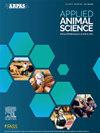Perspectives and Commentary: Fat nutrition and metabolism of early-lactation dairy cows
IF 1.5
Q3 AGRICULTURE, DAIRY & ANIMAL SCIENCE
引用次数: 0
Abstract
Purpose
My objective was to review key factors involved in identifying and characterizing how dairy cows metabolize fat sources and their resultant effects on DMI, milk fat depression, and body condition, with emphasis on early lactation. Thus, short-term, mid-lactation studies were not included.
Sources
The main sources of information were peer-reviewed journal articles, some dairy nutrition conference proceedings, a monograph, several abstracts, a still pertinent periodical article (Lock and Bauman, 2007), and 50 yr of research and field experiences in this area.
Synthesis
Forms of fat, such as triglycerides or free fatty acids whether unsaturated or saturated, affect DMI, milk fat depression, and body condition. The more unsaturated that fatty acids (FA) are, especially the amount of linoleic acid, the more negatively these facets are affected.
Conclusions and Applications
Know what kinds of fat sources are being fed. What is the FA composition of feedstuffs fed and fat sources, especially the UFA and their levels? The more UFA sources there are, the more DMI and milk fat percentage may be negatively affected. Linoleic FA is a key marker for these negative effects, which may ensue if daily intake of linoleic acid is 300 to 400 g or more. This can be exacerbated by other factors such as low dietary forage levels, greater starch, wet forages, and finely chopped forages, which all contribute to lower rumen pH, which facilitates milk fat depression. Reduction in DMI is the major consideration when fat supplementation occurs, with digestibility of fat supplements being a secondary consideration. Either palmitic or stearic acid above 80%, but especially above 90%, in a fat supplement is of concern and may be less digestible because they can become more crystalline. This can also be a factor when physically blending these single sources together. However, if these 2 FA sources are melted and then prilled, this crystalline formation is not likely to occur. Palmitic and stearic acids melted together and then prilled incorporate the complementary benefits of both, potentially in ratios of 1:1 to 2:1, palmitic to stearic acid.
展望与评论:泌乳早期奶牛的脂肪营养与代谢
本研究的目的是回顾识别和描述奶牛代谢脂肪来源的关键因素,以及它们对DMI、乳脂抑制和身体状况的影响,重点是泌乳早期。因此,短期、中期泌乳研究未纳入。信息的主要来源是同行评议的期刊文章、一些乳制品营养会议记录、一本专著、几篇摘要、一篇仍然相关的期刊文章(Lock and Bauman, 2007),以及该领域50年的研究和实地经验。脂肪的合成形式,如甘油三酯或游离脂肪酸,无论是不饱和的还是不饱和的,都会影响DMI、乳脂抑制和身体状况。脂肪酸(FA)越不饱和,尤其是亚油酸的含量越高,这些方面受到的负面影响就越大。结论与应用了解饲料的脂肪来源,饲料中脂肪酸的组成和脂肪来源,特别是不饱和脂肪酸的含量及其水平。UFA来源越多,DMI和乳脂率可能受到的负面影响越大。亚油酸FA是这些负面影响的关键标志,如果每天摄入亚油酸300至400克或更多,这些负面影响可能会随之而来。其他因素如饲粮饲料水平低、淀粉含量高、湿饲料和切碎的饲料等也会加剧这种情况,这些因素都会降低瘤胃pH值,从而有助于降低乳脂。当脂肪补充发生时,DMI的减少是主要考虑因素,脂肪补充的消化率是次要考虑因素。棕榈酸或硬脂酸超过80%,特别是超过90%,在脂肪补充剂中是值得关注的,可能不易消化,因为它们会变得更结晶。在物理上将这些单一源混合在一起时,这也可能是一个因素。然而,如果这两种FA源被熔化,然后被碾压,这种晶体的形成就不太可能发生。棕榈酸和硬脂酸融化在一起,然后以1:1到2:1的比例,将两者的互补优势结合在一起。
本文章由计算机程序翻译,如有差异,请以英文原文为准。
求助全文
约1分钟内获得全文
求助全文

 求助内容:
求助内容: 应助结果提醒方式:
应助结果提醒方式:


